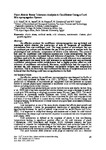PLANT ABIOTIC STRESS TOLERANCE ANALYSIS IN CAULIFLOWER USING A CURD MICROPROPAGATION SYSTEM
| dc.contributor.author | Rihan, Hail | |
| dc.contributor.author | Al-Issawi, M | |
| dc.contributor.author | Al-Shamari, M | |
| dc.contributor.author | Elmahrouk, M | |
| dc.contributor.author | Fuller, MP | |
| dc.date.accessioned | 2016-02-04T17:25:17Z | |
| dc.date.available | 2016-02-04T17:25:17Z | |
| dc.date.issued | 2015-05 | |
| dc.identifier.issn | 0567-7572 | |
| dc.identifier.issn | 2406-6168 | |
| dc.identifier.uri | http://hdl.handle.net/10026.1/4266 | |
| dc.description.abstract |
An effective protocol for cauliflower micropropagation was optimised and developed which enabled the production of tens of thousands of cauliflower microshoots from one cauliflower curd. The large number of microshoots that can be produced per culture unit facilitates the use of this protocol to analyse both the physiological and molecular components of abiotic stress tolerance. The protocol was used for cauliflower cold tolerance analysis and it was demonstrated that low temperature acclimation increased the cold tolerance of explants. The effect of two additives used with the cauliflower culture media on cold tolerance were evaluated. ABA significantly decreased both cold tolerance in acclimated and non-acclimated cauliflower microshoots whilst molybdenum had a highly positive effect on cold tolerance of cauliflower microshoots. Moreover, molybdenum had the capacity to increase the cold tolerance of cauliflower microshoots without low temperature treatment. This is the first study that confirmed this feature of molybdenum and it is believed that this finding could have an application in the field. | |
| dc.format.extent | 43-52 | |
| dc.language.iso | en | |
| dc.publisher | International Society for Horticultural Science (ISHS) | |
| dc.subject | abiotic stress | |
| dc.subject | artificial seeds | |
| dc.subject | cold tolerance | |
| dc.subject | meristematic clusters | |
| dc.subject | plant growth regulator | |
| dc.title | PLANT ABIOTIC STRESS TOLERANCE ANALYSIS IN CAULIFLOWER USING A CURD MICROPROPAGATION SYSTEM | |
| dc.type | journal-article | |
| dc.type | Conference Proceeding | |
| plymouth.author-url | https://www.webofscience.com/api/gateway?GWVersion=2&SrcApp=PARTNER_APP&SrcAuth=LinksAMR&KeyUT=WOS:000378616100003&DestLinkType=FullRecord&DestApp=ALL_WOS&UsrCustomerID=11bb513d99f797142bcfeffcc58ea008 | |
| plymouth.issue | 1083 | |
| plymouth.volume | 1083 | |
| plymouth.publication-status | Published | |
| plymouth.journal | Acta Horticulturae | |
| dc.identifier.doi | 10.17660/actahortic.2015.1083.3 | |
| plymouth.organisational-group | /Plymouth | |
| plymouth.organisational-group | /Plymouth/Faculty of Science and Engineering | |
| plymouth.organisational-group | /Plymouth/Faculty of Science and Engineering/School of Biological and Marine Sciences | |
| plymouth.organisational-group | /Plymouth/REF 2021 Researchers by UoA | |
| plymouth.organisational-group | /Plymouth/REF 2021 Researchers by UoA/UoA06 Agriculture, Veterinary and Food Science | |
| plymouth.organisational-group | /Plymouth/Users by role | |
| plymouth.organisational-group | /Plymouth/Users by role/Academics | |
| dc.rights.embargodate | 2015-11-01 | |
| dc.identifier.eissn | 2406-6168 | |
| dc.rights.embargoperiod | 6 months | |
| rioxxterms.versionofrecord | 10.17660/actahortic.2015.1083.3 | |
| rioxxterms.licenseref.uri | http://www.rioxx.net/licenses/under-embargo-all-rights-reserved | |
| rioxxterms.type | Journal Article/Review |


